Italy and cheese is a match made in heaven.
This universal truth is particularly applicable to the Northern Italian region of the Veneto where many must-try varieties of cheese are produced.
Blessed with lush pastures, hundreds of small dairy farms (known as malga) and centuries-old cheese-making traditions, the Veneto is a paradise for cheese lovers. Such is the quality of the local cheese offerings that several types of cheese produced here like Asiago, Grana Padano, and Provolone Valpadana, carry the esteemed mark of protected designation of origin (DOP).
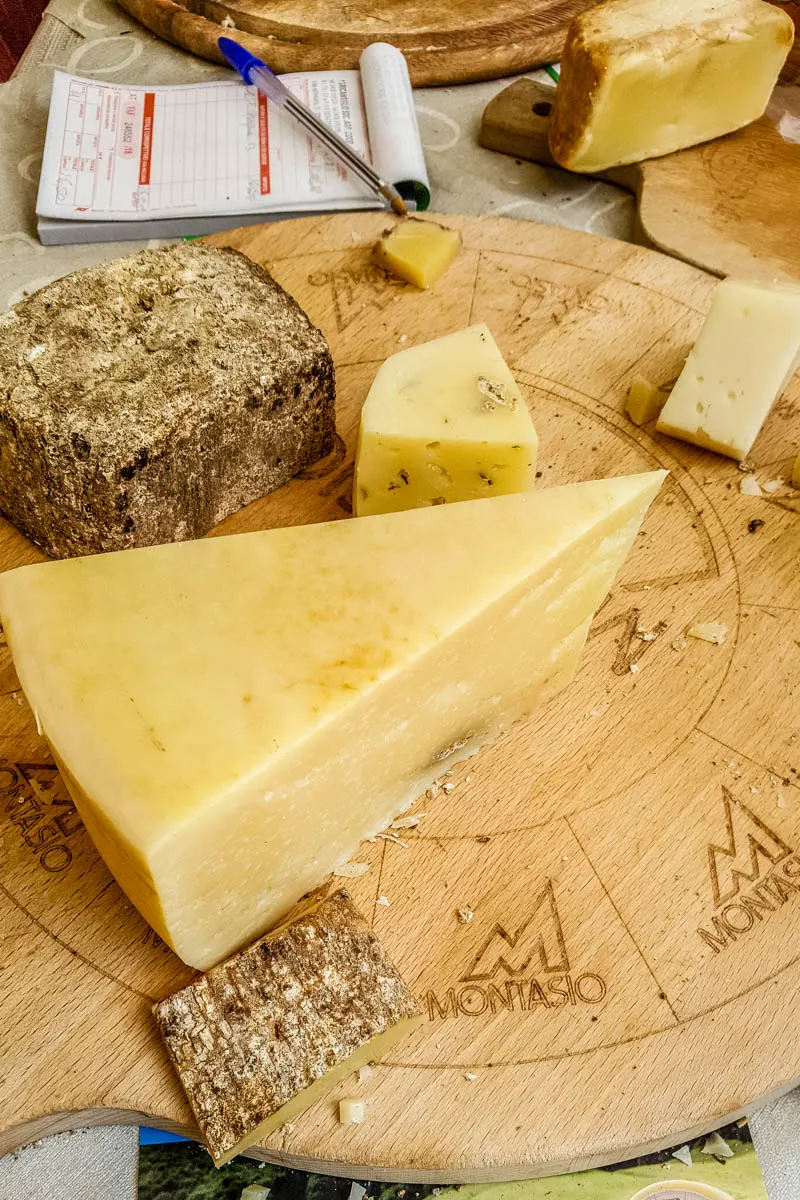
Cow, sheep, and goat milk are used for the production of cheeses in the Veneto.
In spring here you can see large herds of cows and endless flocks of sheep being moved from the Venetian plains to the mountains of the Veneto where they spend the hot months peacefully grazing lush grass and herbs.
In late summer/early autumn, the herds and flocks are brought from the mountains back to the plains.

This centuries-old process of seasonal moving of livestock is known as transumanza and it’s a period of celebration of cheese.
In addition, large cheese festivals take place every year in the Veneto, too. This is where cheese producers both from the region and all over Italy show hundreds of varieties of cheese to the discerning public.
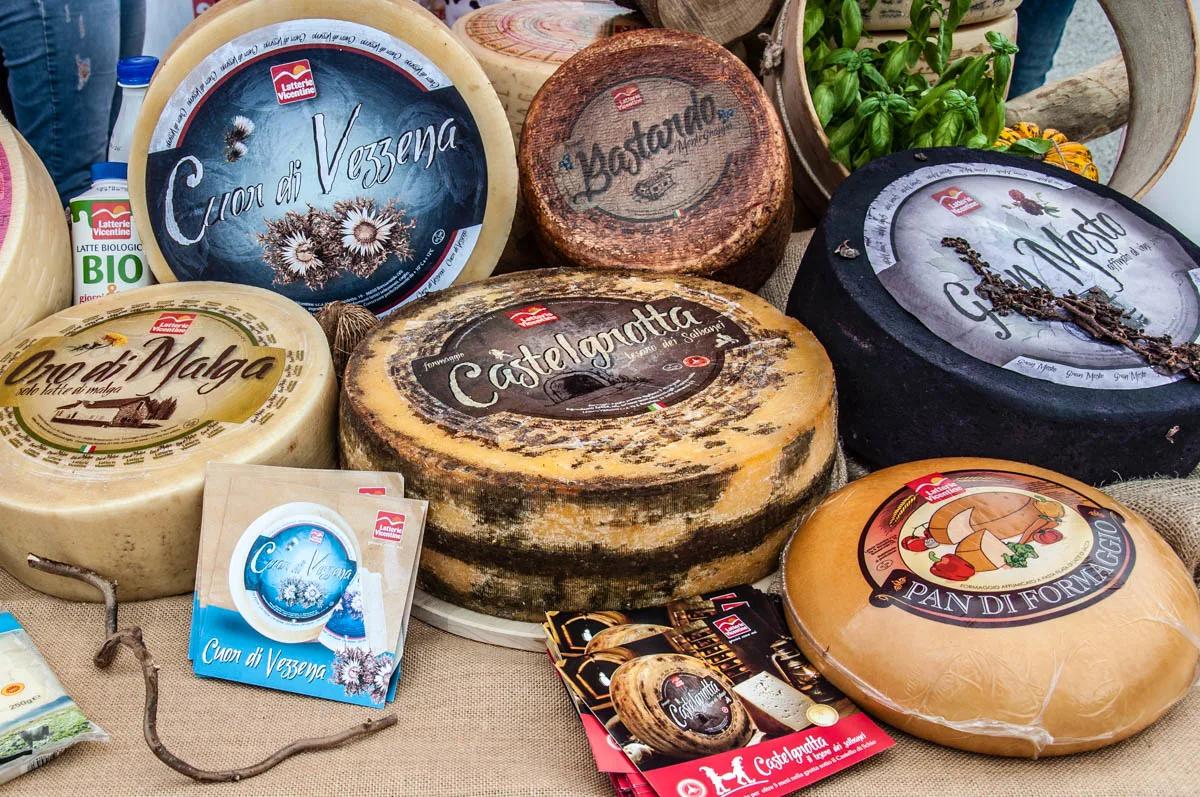
Still, you don’t have to come to the Veneto specifically for a transumanza event or a cheese festival in order to sample the best cheeses this Northern Italian region has to offer. Cheese here is at the table any day of the week and it’s practically a way of life.
From small delis to large supermarkets, from small cheese-makers to large cheese producers, excellent cheese is everywhere in the Veneto and there are enough cheese varieties here to satisfy every cheese preference.
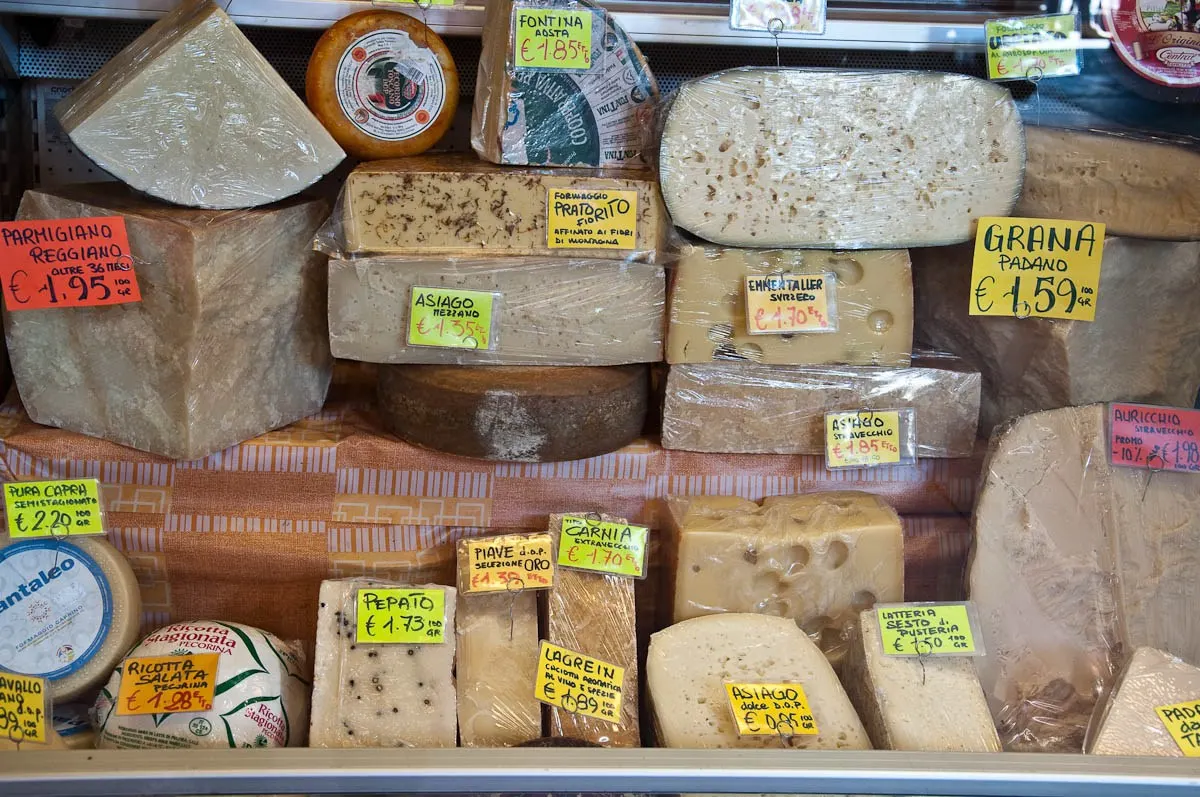
So, in this blog post, I want to introduce you to five of the tastiest and most famous cheeses in the Veneto, Northern Italy. From their history to what they look and taste like, everything is covered.

In addition, further below, I have provided ten unmissable cheese experiences to have in the Veneto.
Ticking them off one by one will help you learn more about the cheese history of the Veneto and the variety of cheese made here.
Visiting a communal dairy farm, buying cheese matured in a cave…
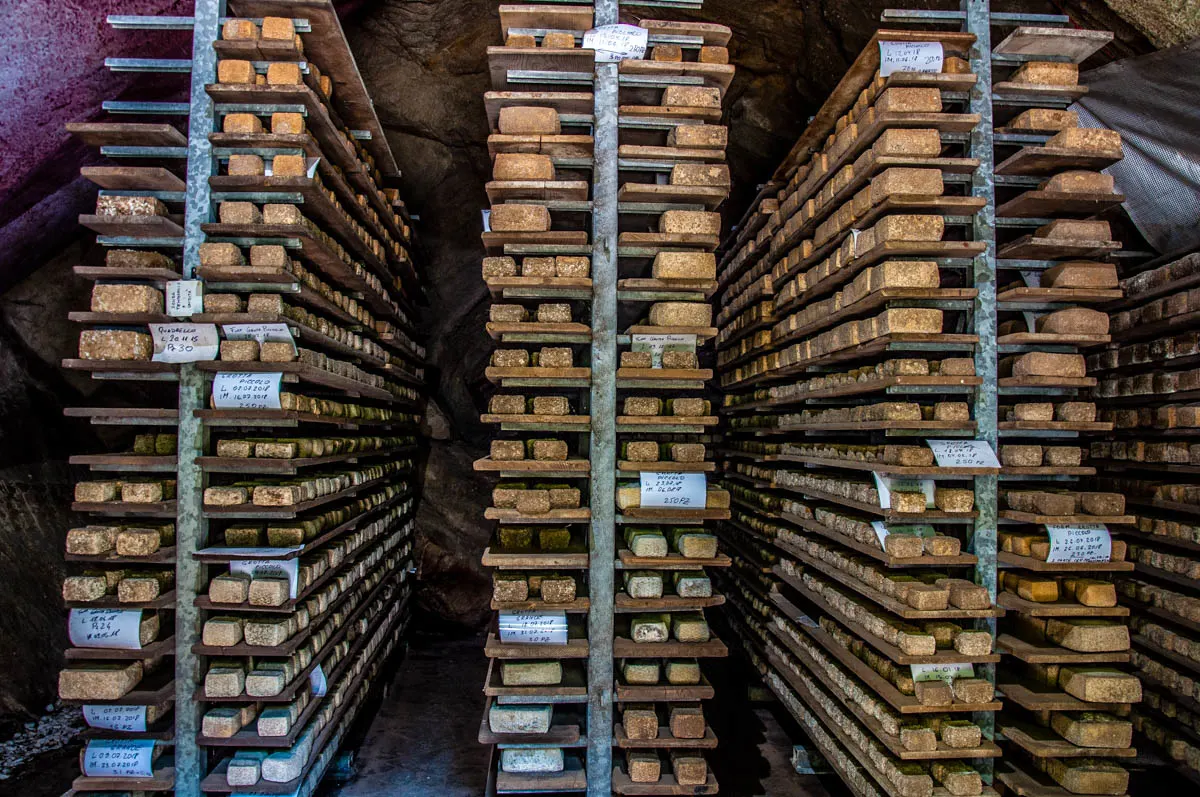
touring the premises of cheese producers large and small…

taking part in a cheese festival, and even spotting cheese graffiti on the historic walls of Venice…

there are many experiences and destinations here in the Veneto, Northern Italy to get your cheese kick.
From cheesy pizzas…

and sarnies loaded with cheese…
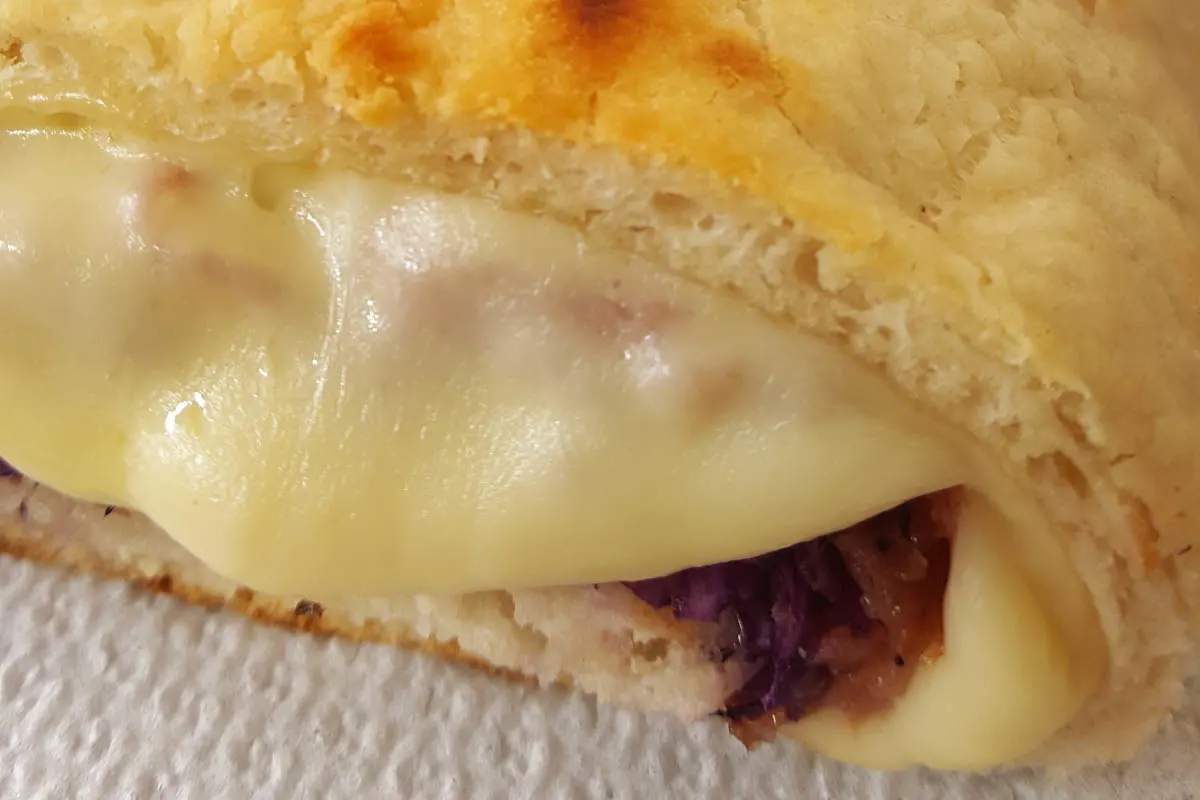
to soups enjoyed with grated cheese…
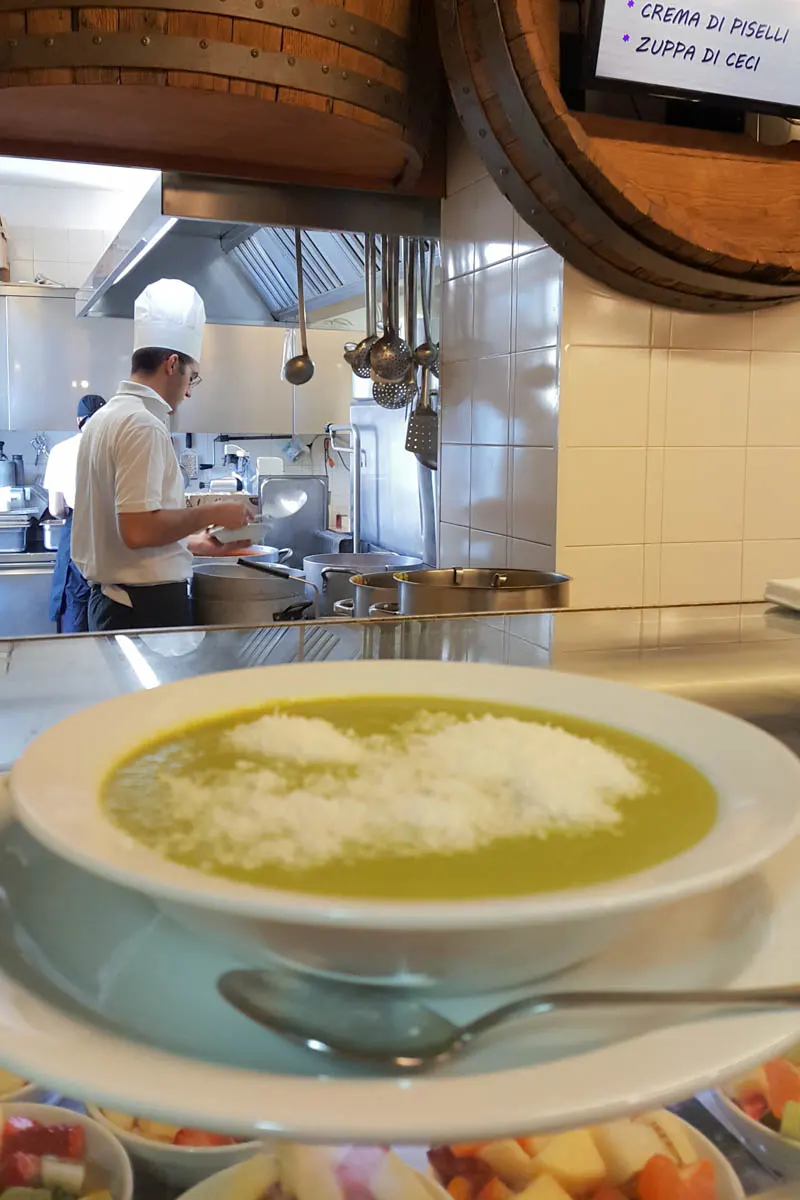
and grilled cheese served with truffle shavings and thick slices of polenta…
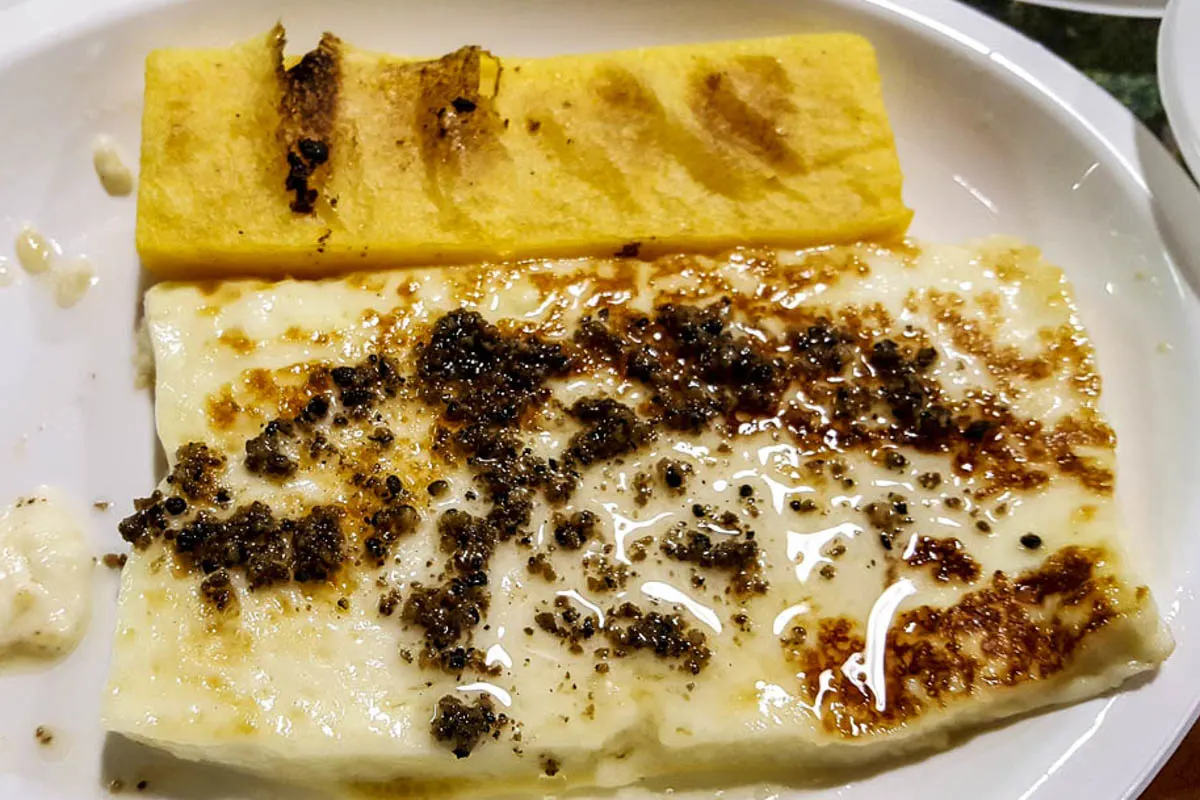
cheese is Veneto and Veneto is cheese.
Keep reading and find out why the Veneto definitely can be considered Italy’s Big Cheese!
Italian Cheeses – 5 Must-Try Cheeses in the Veneto, Northern Italy
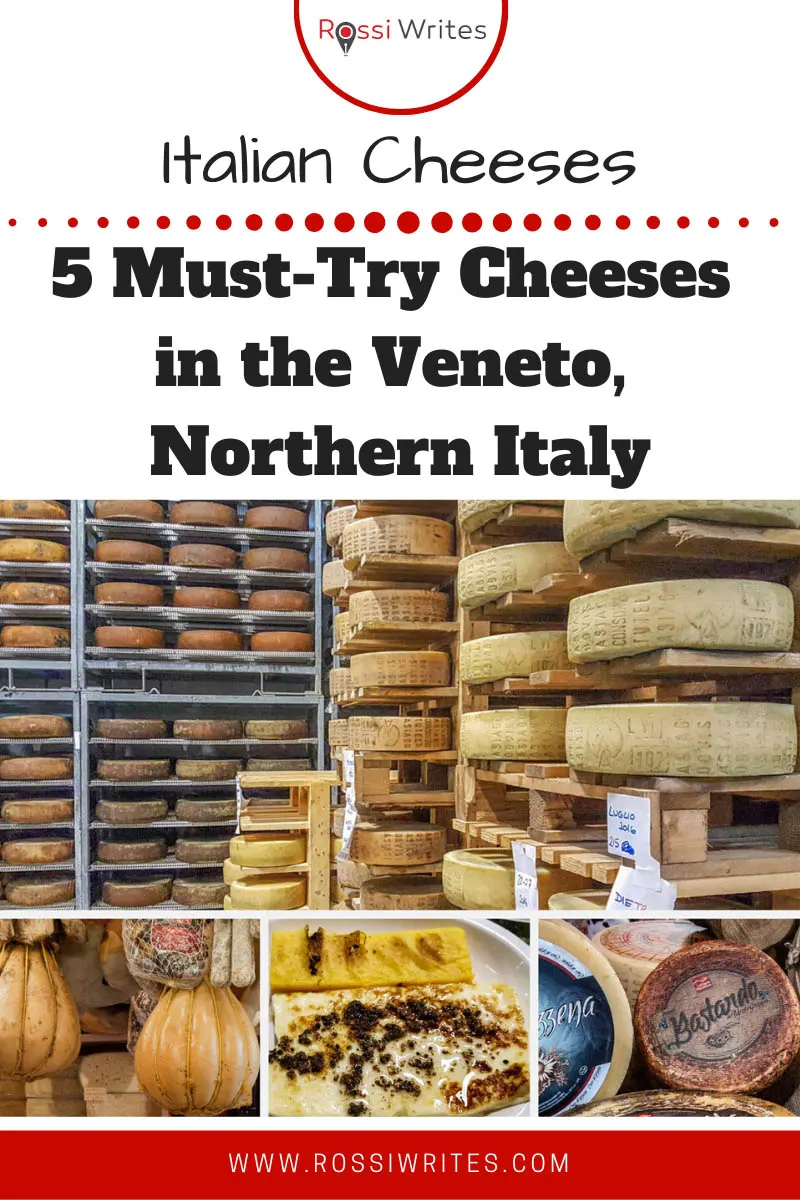
Asiago Cheese DOP
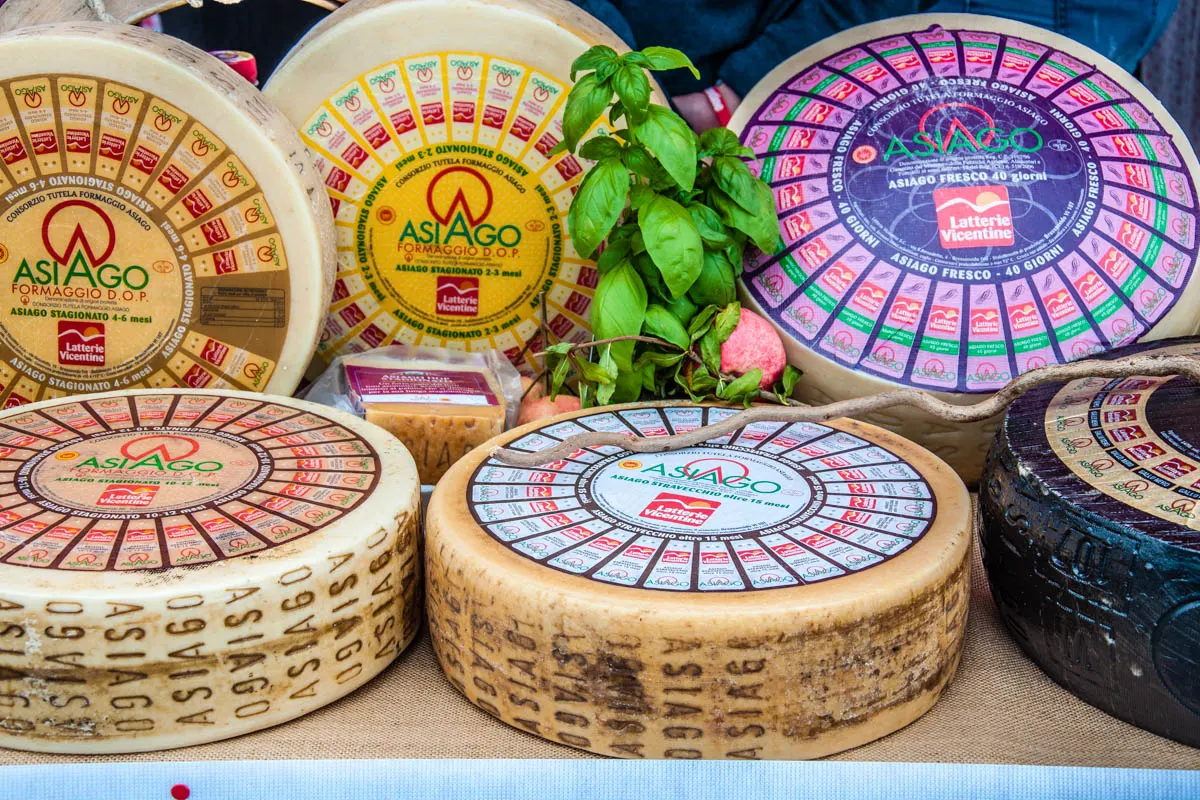
This is my most favourite cheese in the Veneto, Italy. I can easily have it with every meal. It comes in several varieties, depending on the length of time it has spent maturing. I love the fresh Asiago cheese which has been left to mature for only twenty days. It tastes very much like butter. Put a cube on your tongue and it will start to melt leaving a lovely buttery taste and a craving for more.
Named after the Asiago Plateau which is the centre of its production, Asiago is a fat or a semi-fat cheese generally obtained from two milkings. The cheese wheels are rather large and can weigh as much as 15 kg. Produced year-round, many attempts have been made to imitate it elsewhere around the world but the original Asiago cheese is only produced in a relatively small area in Italy. It comprises the Province of Vicenza in the Veneto, the Autonomous Province of Trentino, and some parts of the Veneto’s Provinces of Padua and Treviso.
The Asiago cheese carries the esteemed mark of protected designation of origin (DOP).
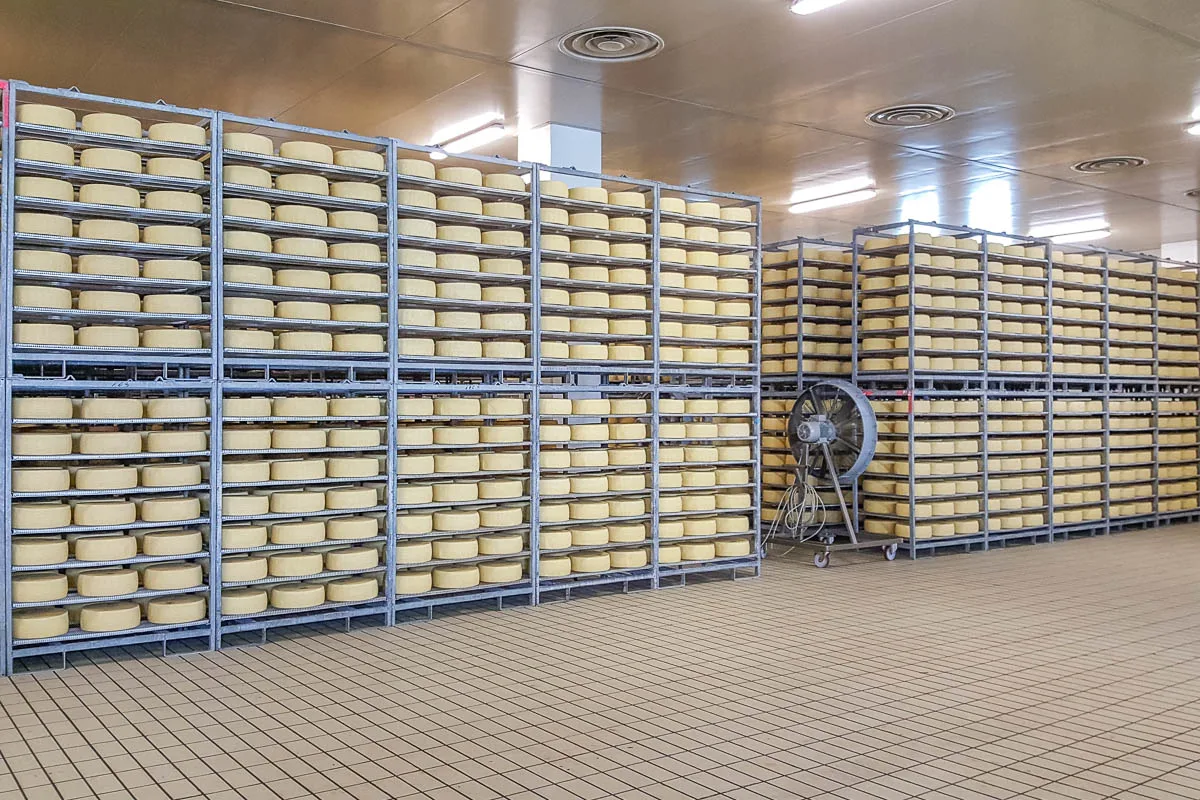
Cheese-making on the Asiago Plateau is a tradition with centuries-deep roots. Documents from as far back as the start of the 10th century AD testify that sheep milk was used there to produce cheese which at the time was known as pegorin. In the 19th century, cow milk took over, and nowadays the Asiago cheese is made entirely with it.
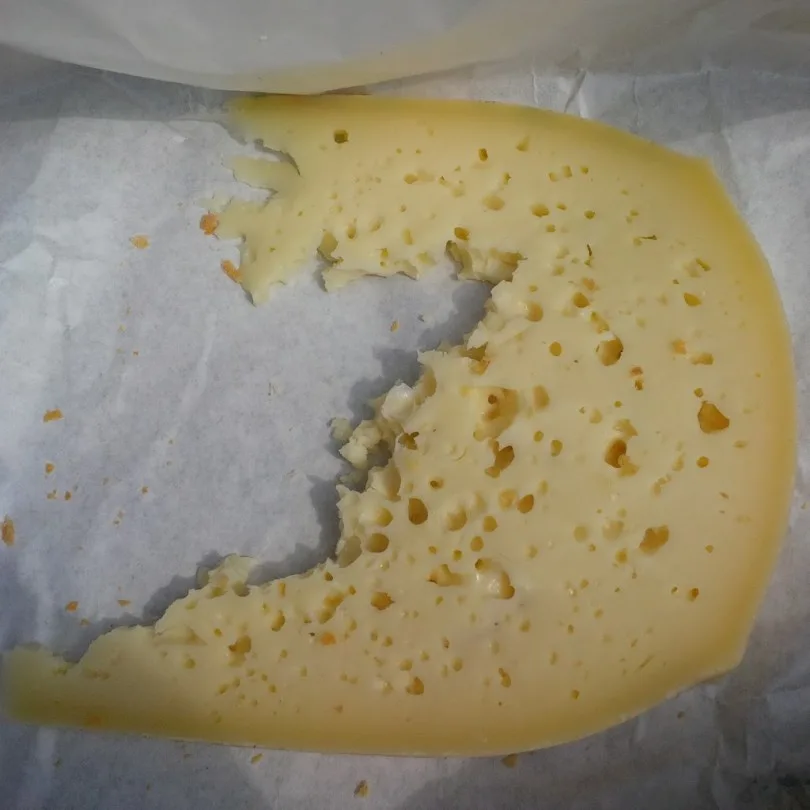
There are two types of Asiago cheese: pressato and d’allevo. They are rather different from one another.
Asiago Pressato has a beautiful buttery or light straw colour. It’s rather soft, it melts on the tongue and has a texture speckled with hundreds of tiny holes with an irregular shape. It’s been matured between 20 and 40 days and it’s very inexpensive. A kilogram can be bought from anything between 7 and 10 euros. It grills wonderfully and it’s very tasty in sandwiches.
Asiago d’allevo is matured from 3 months to up to two years. This type of Asiago cheese has three varieties depending on the time that the cheese wheels have spent on the shelf developing: Mezzano (three to eight months), Vecchio (nine to 18 months), and Stravecchio (more than 18 months). The older it is, the harder it gets and the more it costs. It’s really tasty grated on top of hot dishes. Or you can simply have a little piece on its own to appreciate the unique salty taste and the grainy texture.
Grana Padano Cheese DOP
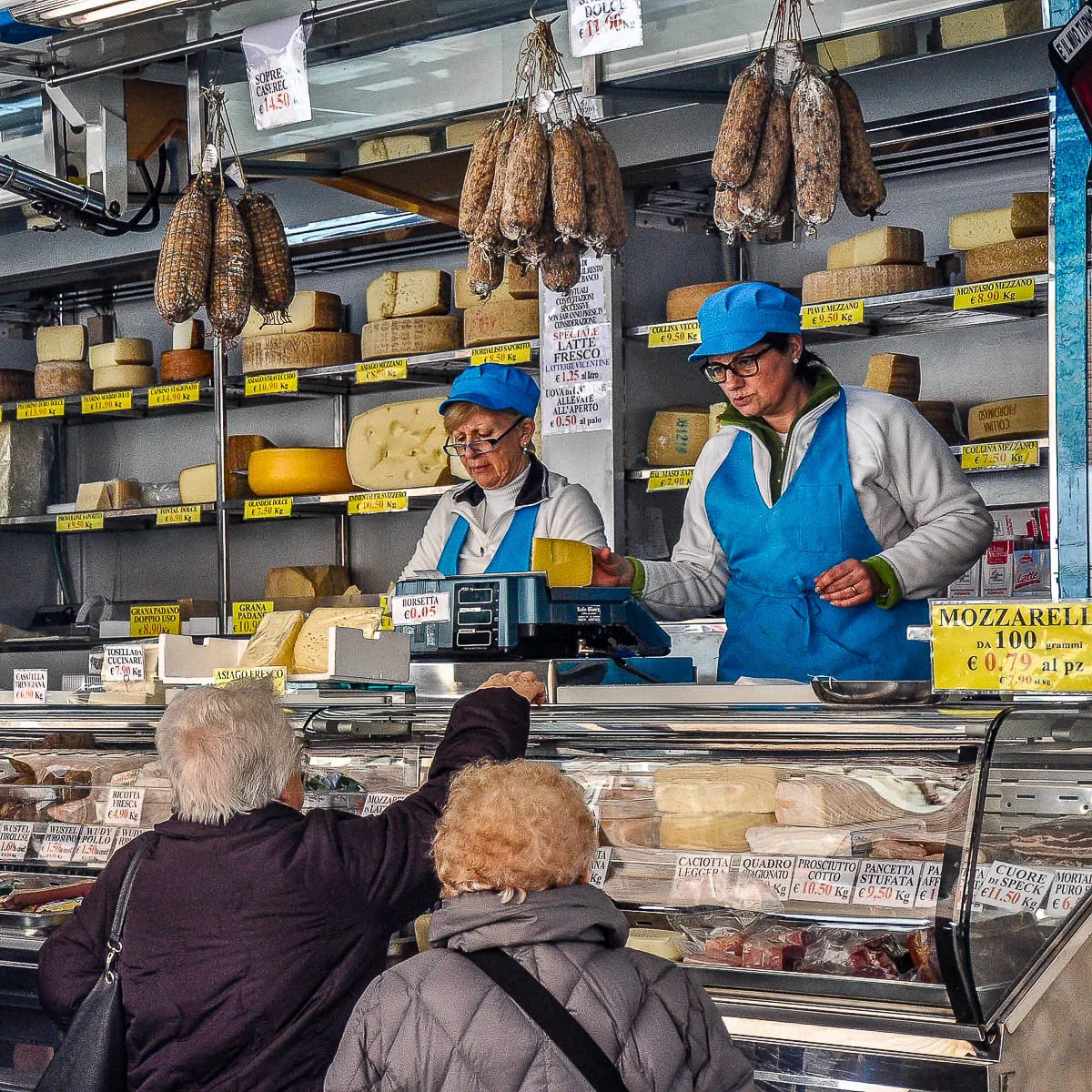
The Grana Padano cheese is produced across the expansive Padana plain – the flatlands around Po, Italy’s longest river. The production of this variety of cheese is concentrated in several provinces that are part of the Northern Italian regions of Emilia-Romagna, Lombardy, Veneto, and Trentino-Alto Adige.
The Veneto is one of the major producers of Grana Padano and the cheese is used in many local and traditional recipes.
Grana Padano is a mature cheese to be eaten on its own as well as grated over meals. It’s especially nice to have with a plate of freshly cooked pasta.
The cheese has a hard rind and a lovely grainy texture which has inspired its name Grana. One kg of Grana Padano takes around 14 kg of cow milk to produce. It needs a long time to mature, starting from nine months. The Grana Padano Riserva variety must be matured for over twenty months.
The cheese wheels weigh between 24 and 40 kg and have a lovely straw or light brown colour on the outside while on the inside the cheese is white-ish or light straw. There are tiny holes distributed regularly across the texture of the cheese.
The Grana Padano cheese carries the esteemed mark of protected designation of origin (DOP).
It is believed that Grana Padano is one of the oldest cheeses in Italy. Its production started over 1,000 years ago in the provinces of Parma and Piacenza in the Northern Italian region of Emilia-Romagna. It then spread across the plain of the river Po and the original name of the cheese Piacentino was changed to Padano.
As the Grana Padano lasts a very long time, in the past it would often be part of the food supplies that pilgrims travelling to Rome, Jerusalem, and Santiago de Compostela would take to sustain them on their long and arduous journeys.
I love to cut myself a nice little chunk of Grana Padano and enjoy it on its own. Its grainy texture is particularly pleasing and if the cheese has been matured longer than 12 months, it has little crystals that are wonderful to crunch on.
Provolone Valpadana DOP
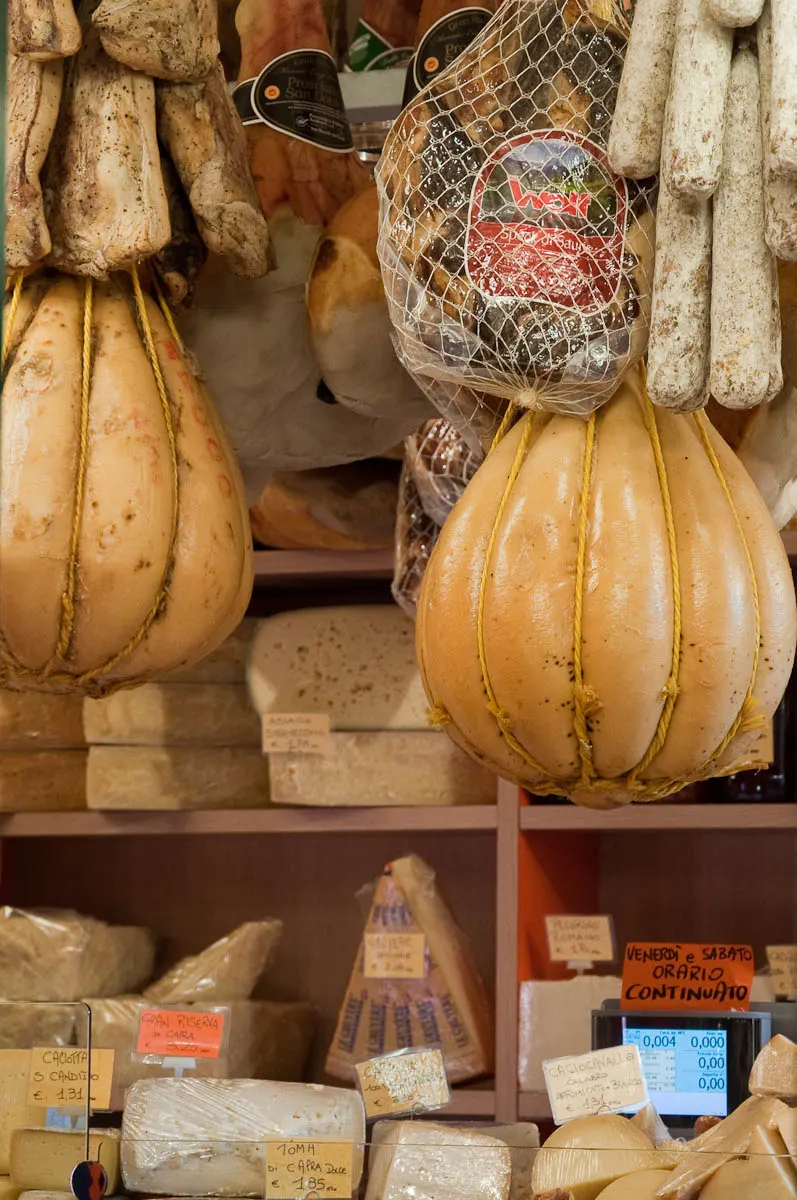
This is a really splendid cheese that conquers the senses with its pungent smell! I love it baked for a few minutes in the oven. Its stretchy texture is a winner each time with me!
In the Veneto, Provolone Valpadana DOP is produced in the Provinces of Vicenza, Verona, Rovigo, and Padua. It is also made in the Northern Italian regions of Lombardy, Emilia-Romagna, and Trentino-Alto Adige.
Made of cow milk, this fatty cheese has a pale straw or almost white colour. It comes in several shapes with cylinder and teardrop being two of the most popular ones. In the supermarkets, you will often find it cut in thick half-moon slices which have been prepacked.
A whole wheel of Provolone Valpadana cheese can weigh anything from half a kilo to 100 kg. To see it in all its splendour, make sure that you pop in the Sotto il Salone – the ground floor of Padua’s Palazzo della Ragione. The delis there sell huge teardrop-shaped wheels of this cheese and it is very cinematic to see them there hanging from the delis’ ceilings.
The Provolone Valpadana cheese carries the esteemed mark of protected designation of origin (DOP).
There are two main types: sweet and piquant. You may also find a smoked variety, too. The cheese is matured for at least 30 days and the piquant variety is matured up to 16 months. The longer it’s matured, the more intense the smell of this cheese is.
Bastardo del Monte Grappa PAT
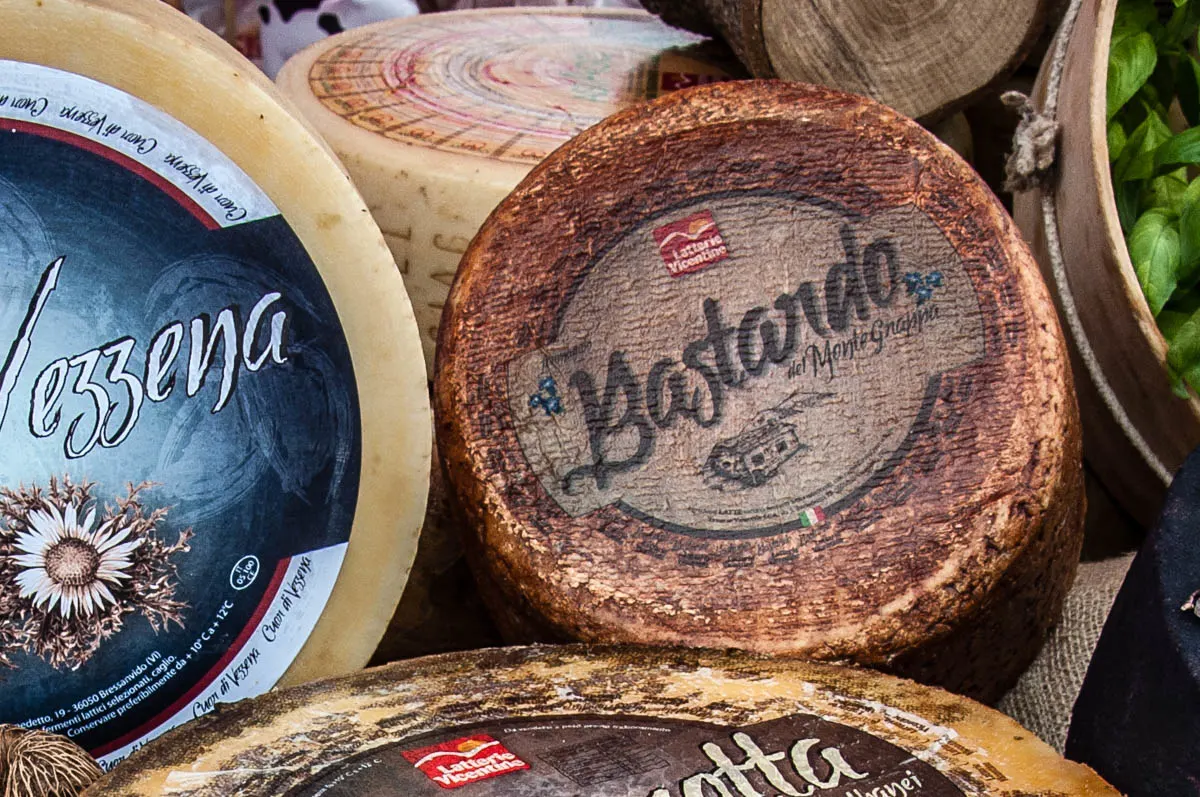
Bastardo del Monte Grappa is an excellent yet little-known cheese of the Veneto. It’s produced only in the foothills of Monte Grappa – a mountain in the Venetian Prealps intrinsically connected to Italy’s World War I and World War II history.
There are many potential explanations as to how this cheese got its somewhat un-PC name – Bastardo – which in English means just what the Italian word implies. One of the main theories is that apparently, the name is due to the fact that the cheese is made from the milk of cows that have grazed on different types of grass. Another popular local belief however is that the name of the Bastardo del Monte Grappa cheese is due to the fact that originally it was produced by mixing cow and sheep and/or goat milk.
This cheese is only produced during the open pasture season from June to September each year.
Bastardo del Monte Grappa matures for at least 45 days. When it is over a year old it is excellent for grating. It’s a semi-hard cheese with a granular texture and white or straw colour which gets darker the longer the cheese wheels are left to mature. It’s dotted with irregular holes of differing sizes, most of them quite tiny.
Bastardo del Monte Grappa Cheese carries the esteemed mark of PAT – prodotto agroalimentare tradizionale – an official approval for traditional Italian food products.
Tosella

Tosella is a fresh curd cheese. It’s sold in rectangular pieces and can be eaten straight after production. I like to prepare it on the day I’ve bought it as to me it tastes the best when it’s super fresh.
When you chew a piece of Tosella, it makes a sound not dissimilar to biting into a new stick of gum. It’s oddly very satisfying.
This cheese is only produced during the open pasture season from June to September each year. It’s made of cow milk in the Province of Belluno and in the seven municipalities of the Asiago Plateau in the Province of Vicenza in the Veneto. As no salt is added to this cheese during its production, you can salt it to taste before consumption.
Pure white in colour and without a rind, Tosella is often grilled or roasted. I like to flash fry it in a pan with just a drizzle of olive oil.
Originally made in the alpine dairy huts (called malga in Italian) by the mountain herdsmen for their own lunch, nowadays Tosella is a much-appreciated cheese sold all over the Veneto.
10 Unmissable Cheese Experiences in the Veneto, Northern Italy

1. Learn How to Say Cheese in Italian
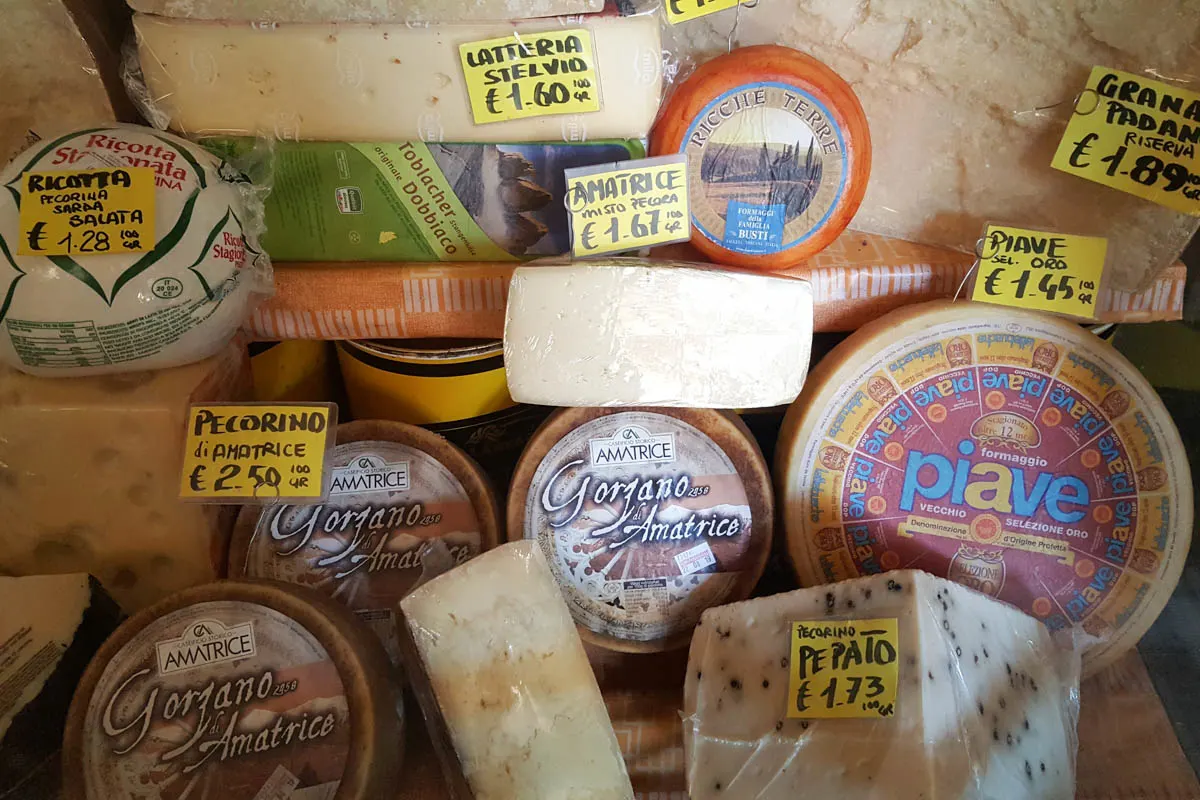
First things first. If you love cheese and you have found yourself in Italy, you will want to learn how to say cheese in Italian. The word you are looking for is formaggio.
A common error (which, I admit, I used to commit, too) is to pronounce it as fromaggio under the influence of the French fromage. Make sure that you say it correctly: FOR-MA-GGIO.
2. Shop for Cheese
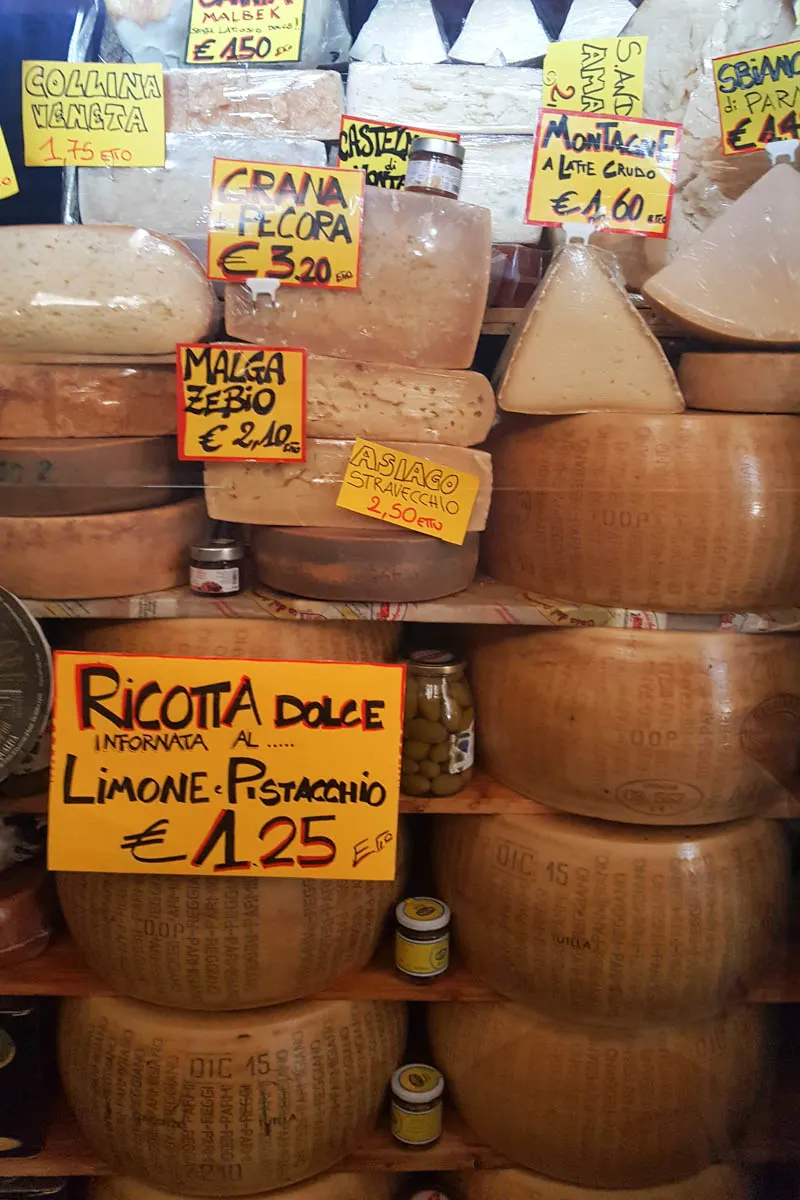
Cheese is everywhere in Italy. Don’t resist it!
Give yourself entirely to cheese! Produced with pride by hundreds of small dairy farms and larger companies, there are hundreds of cheese varieties all over Italy and dozens of them in the Northern Italian region of the Veneto.
A good way to get to know the local cheeses and to decide which ones you like is to head to the local markets, delis, and supermarkets and buy a small slice from three or four different varieties of cheese. Shop assistants are usually very happy to recommend cheese and to give you lots of tips about how to best consume it.
Bear in mind that all this information will be given in fast Italian but the desire to help is there.
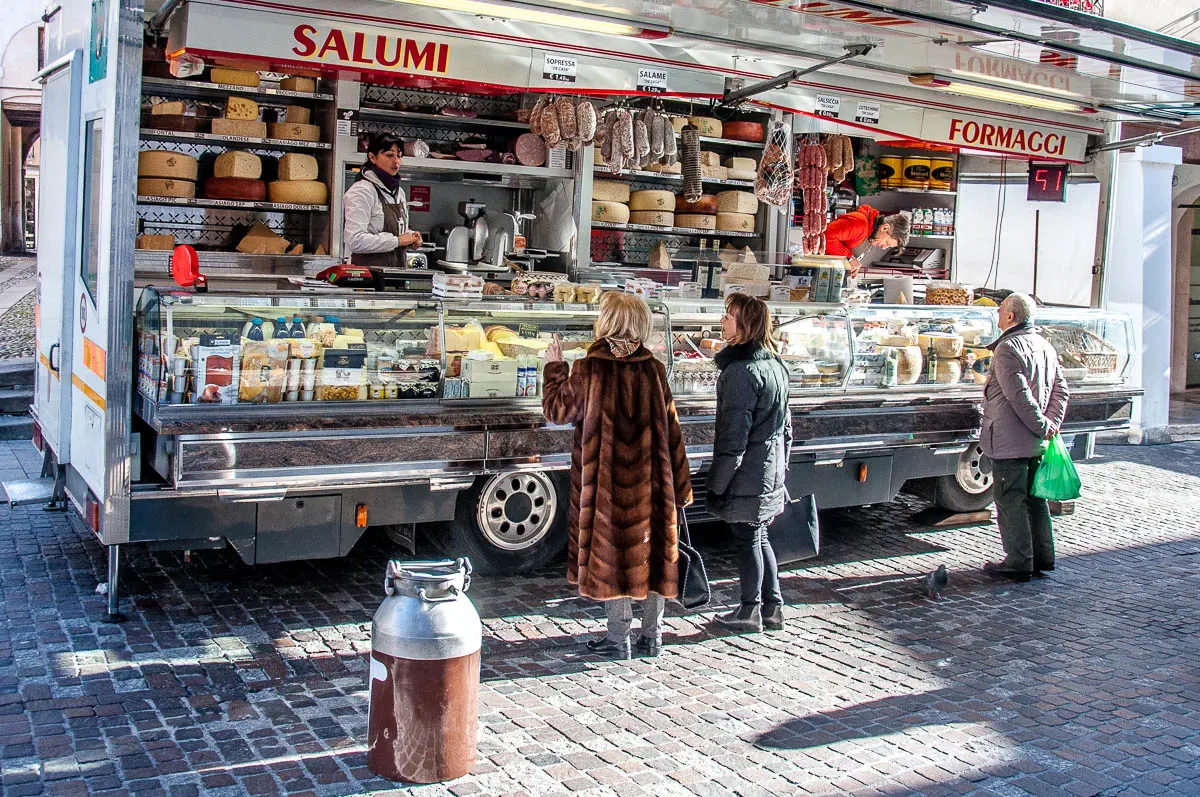
At weekly local markets, keep an eye out for large vans which turn into shops with huge cold displays at the front and lots of shelves at the back. They sell lots of local cheeses.
I also like to shop for cheese in the branches of Latterie Vicentine – the biggest producer of Asiago DOP in the Province of Vicenza, Veneto. The company also makes a rich pallette of many other dairy products. Its shops are great for cheese and dairy lovers and there is a branch in many cities and towns of the Province of Vicenza.
Any supermarket you enter in the Veneto will have a very rich selection of cheeses coming both from local and national producers.
3. Visit a Cheese Festival

There are many food and cheese oriented events held each year all over Italy. Specifically for the Northern Italian region of the Veneto, here are the most important cheese festivals to pencil in your calendar now:
- Made in Malga – an event held in the Asiago Plateau in the Province of Vicenza over two weekends in September of each year to celebrate the varieties of cheese made in the small dairy farms of Italy’s mountains.
- Caseus Veneti – a regional competition between the cheese producers of the Veneto. It takes place yearly on a weekend in September in the plush surroundings of the splendid historical Villa Contarini in the small town of Piazzola sul Brenta in the Province of Padua.
In addition, many food festivals that are held regularly in the Veneto offer a chance to sample and buy many different types of cheese from all over Italy. A very good destination in this regard is the food fair CosmoFood which takes place every November in the city of Vicenza.
4. Hike to Small Dairy Farms
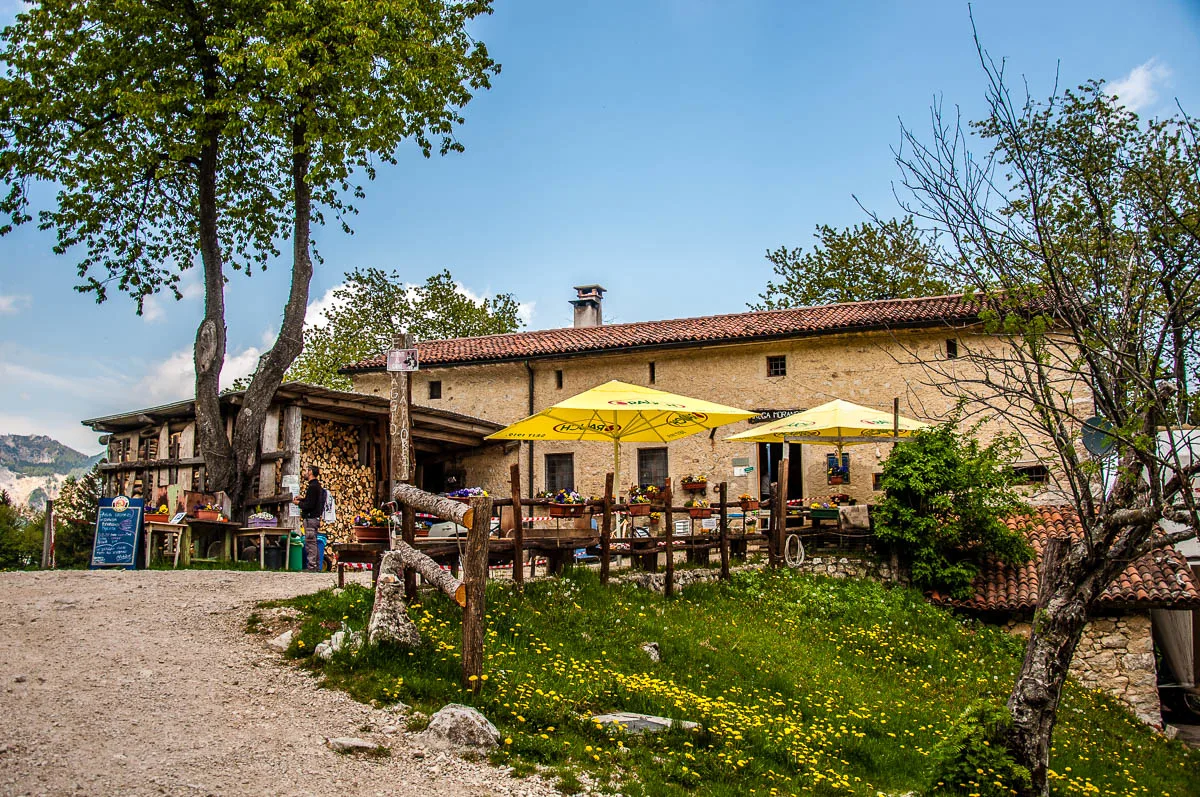
The mountains and hills of the Veneto are dotted with small dairy farms which in Italian are known as malga. These are independent farms that make their own cheese and sell a good variety of fresh dairy products.
Set up in the most picturesque corners of the Veneto, there are many itineraries that take you on a walk from malga to malga while giving you a chance to get in touch with the beautiful nature and stunning panoramic views of this corner of Italy.
Here are two suggestions for malga-dotted hikes to get you started:
- Sentiero dei Grandi Alberi – a very easy and pleasant hike in the Little Dolomites in the Veneto. Along the way, you will come across several malghe for a first-hand experience of this side of Italian life.
- Hike of the malghe in Verena – an easy and picturesque walk taking in several malghe on the Asiago Plateau. Please, note that the link provided is in Italian. Google Translate will help you get the gist of the information.
5. Learn about the Tradition of Communal Dairies

Head to the small medieval village of Molina in the Province of Verona. You will find it right next to a famous waterfall park but the village itself is more than worth it a visit. With houses, the rooftops of which are covered with large slabs of grey slate extracted from the surrounding hills and with a couple of centuries-old mills nearby, the village of Molina has another hidden ace up its sleeve.
This is where you can visit a malga turnaria – a small dairy farm that worked on the principle of ‘taking turns’. The local families – each owning at least one cow or a few sheep – were communal members of the malga.
Each day each member of the collective would take to the malga the fresh milk and write the number of litres brought in on a specific measuring tool. The quantity was then added to his credit or debit.
The member with the most credit could take everybody’s milk and use it to make cheese. The litres of milk used were then subtracted from his credit. He would then repay the used quantity of milk by bringing his milk to the malga in the following days. This way, each member of the malga turnaria would have enough milk to make cheese for his family.
Nowadays, the malga turnaria in the village of Molina has been carefully restored and is used as a place to hold cheese-making workshops.
More information:
Parco delle Cascate and Molina – A Great Day Out in the Province of Verona
6. Buy Some Cave-Matured Cheese
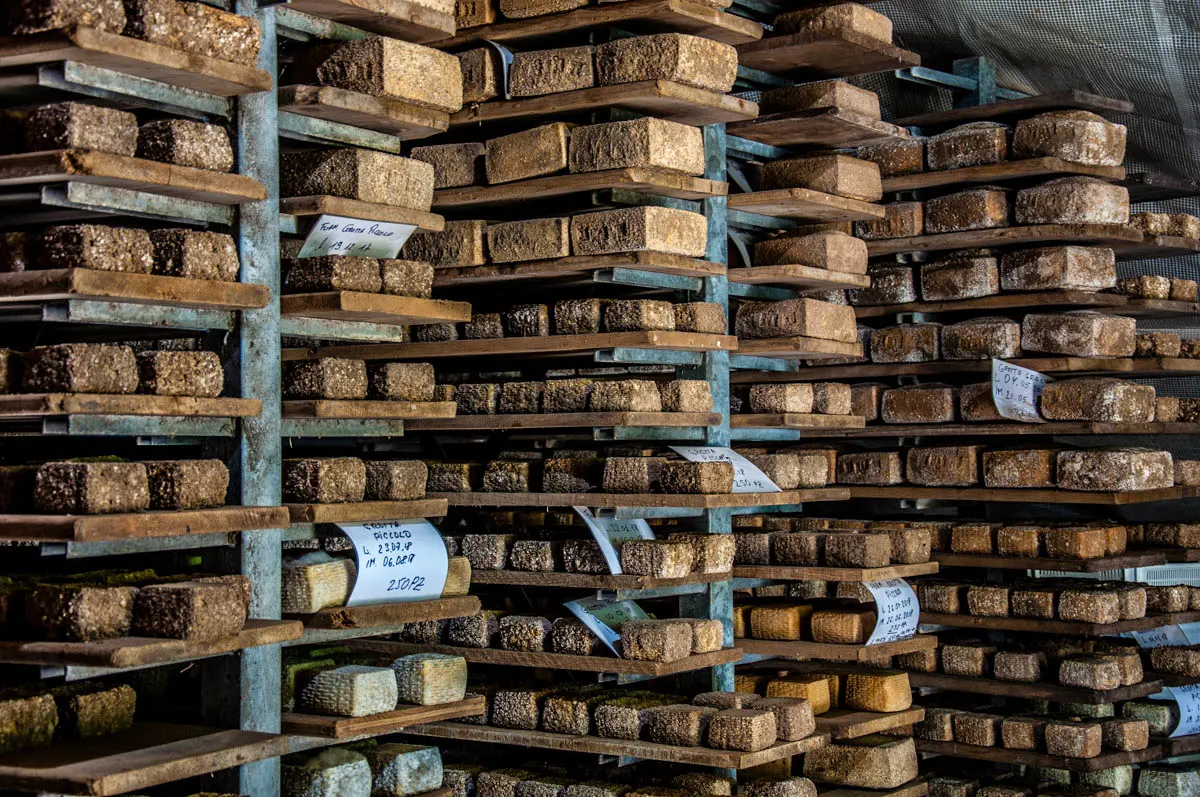
Using a cave to ripen cheese is a centuries-old technique still practiced in Italy nowadays. Caves provide a controlled environment with a stable temperature and act like one huge natural fridge.
Walking into a cave used for the ripening of cheese is quite the sensory experience with the pungent smell enveloping you in a tight embrace. The slabs of cheese – neatly ordered on wooden shelves – spend between two and four months in the cave while their flavour develops and matures. In the process, a thick crust grows naturally around the cheese and it needs to be cut off before eating.
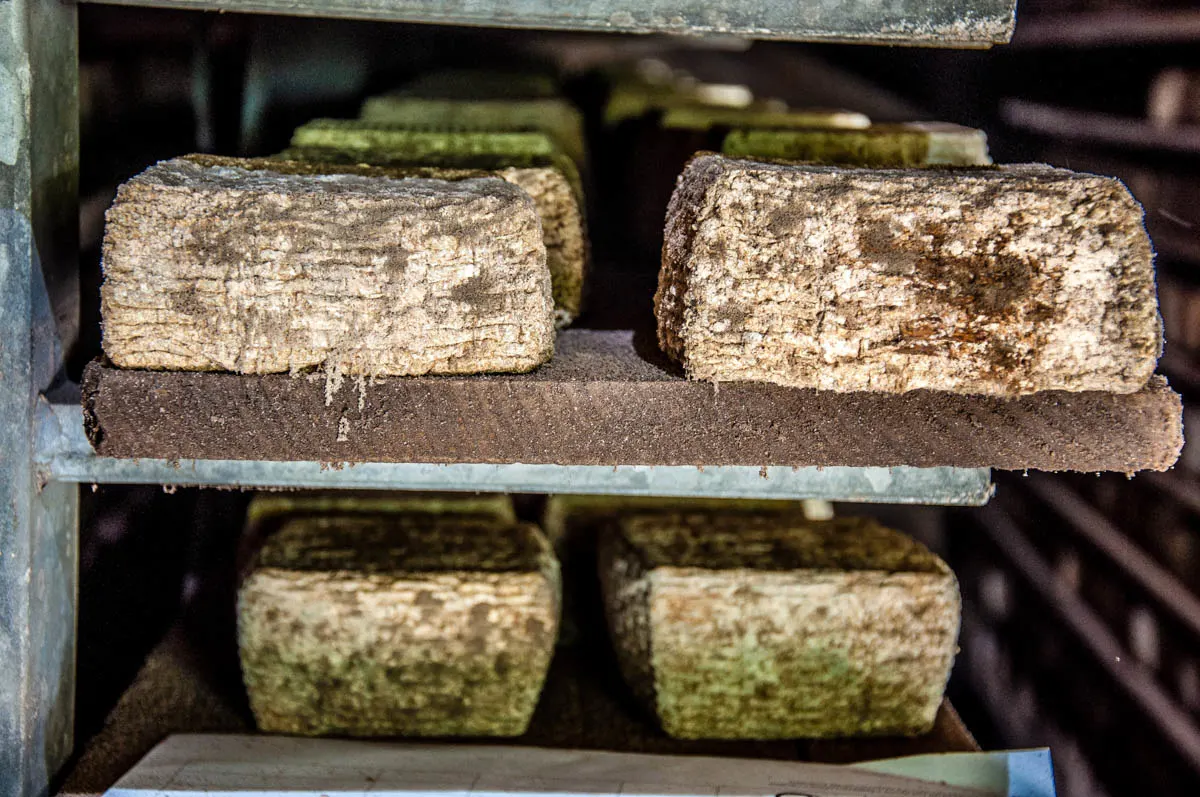
A great cheese cave to visit in the Veneto is part of a spot of natural beauty called Grotte del Caglieron. This is a labyrinth of small caves and waterfalls that is a pleasure to hike through for a nice, relaxing walk.
One of the caves here – the Grotta di San Lucio – is used for the ripening of cheese produced by a local dairy cooperative called Agricansiglio. Slabs of raw milk cheese are neatly placed on numerous wooden shelves inside the cave and left there to mature.
When the cave is open, a cheese-selling stall is placed in front of it. This way, you can see the cheese maturing inside the cave and then sample and purchase the cheese at the stall outside. It’s a unique experience!
More Information:
7. Eat Cheese Matured in a WW2 Bomb Shelter
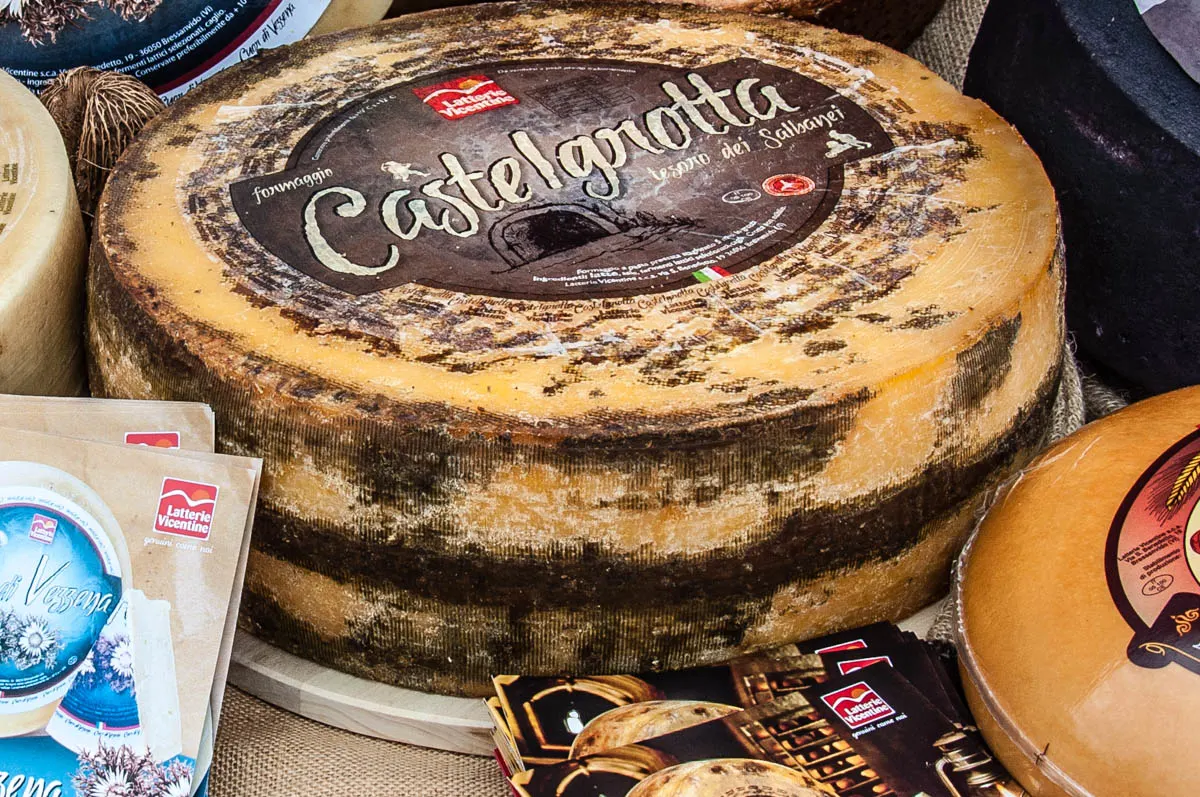
Castelgrotta is a unique cheese produced in the Veneto. It stands out with the fact that it’s matured in a former bomb shelter in the small town of Schio in the Province of Vicenza. Schio’s moniker is the Manchester of Italy for this is where high-quality textiles have been produced for centuries.
The shelter was excavated during the Second World War in order to provide a safe place for all the school children and wool factory workers. At the time, each city and town in Italy had to excavate a shelter following orders by Mussolini.
The shelter is 100 m long and has seven rooms. It is inside a hill on which the remains of Schio’s medieval castle stand. The town was badly bombed by the American Forces on 14th February 1945 (at the same time when Dresden in Germany was bombed, too).
8. Watch Cheese Being Made
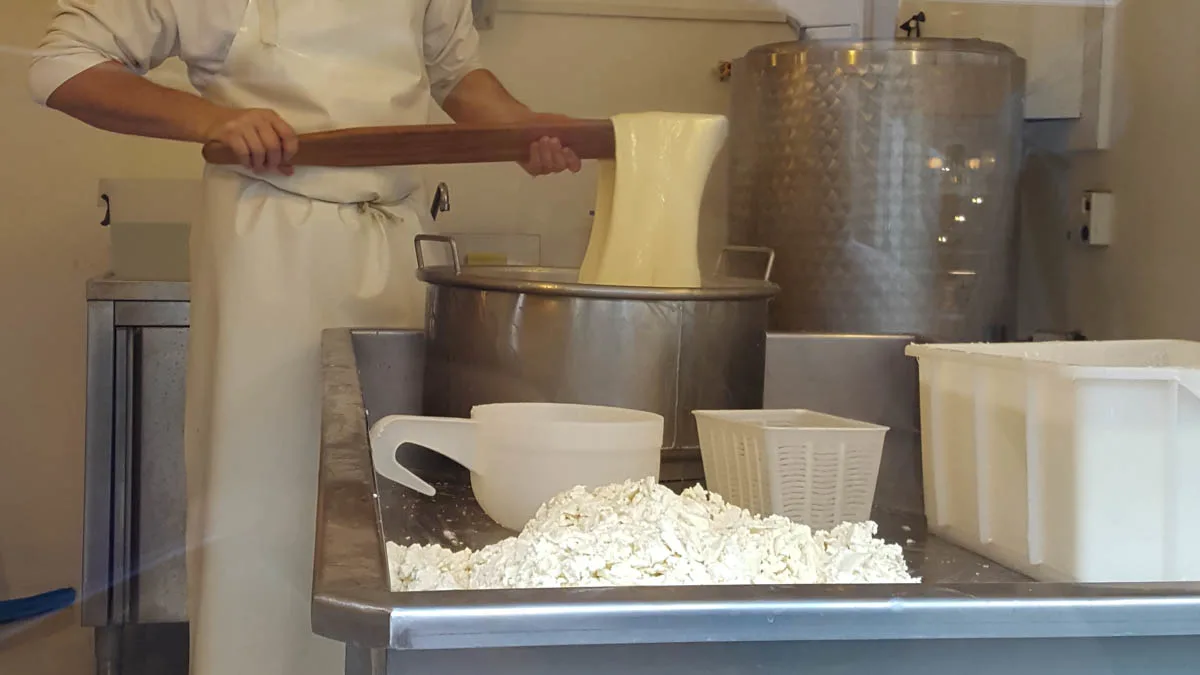
It’s only natural to want to see how cheese is made, especially in the Veneto with its many varieties of cheese and centuries-old cheese-making traditions.
Some large producers here open the doors of their factories once or twice a year in relation to a particular event. Yet, if you simply want to peek into a cheese-making workshop and you don’t have much time to hang around, there is nothing better than to head to Puro Latte in Padua and watch their skilled dairy makers preparing fresh batches of cheese on the spot.
Puro Latte calls itself an oficina casearia which in English translates as a dairy workshop. It is basically a shop selling fresh dairy products and it has a studio attached to it where cheese is made. A large window facing Padua’s Piazza Eremitani allows you to observe the action up close and personal.
You will find Puro Latte right behind the famous Eremitani Church in Padua. It is very central and easy to locate.
I have had the chance to watch from behind the glass several times just by pure luck of passing by and then have purchased from the delicious dairy products they have inside the shop.
9. Take Part in a Transumanza Event
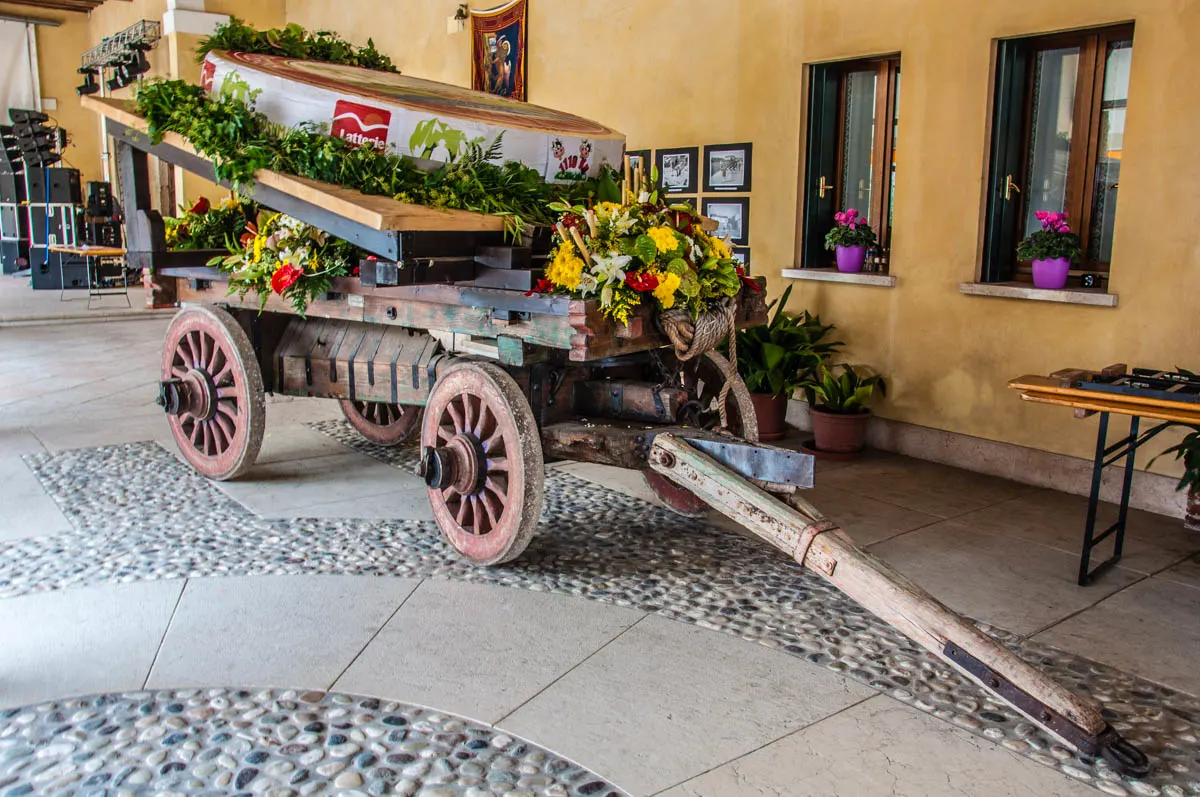
Transumanza is a melodious word used to describe an event that takes place twice a year and which in the past was of utmost importance for the dairy-producing communities in Northern Italy.
This is the dispatch in spring of the herds of cows and the flocks of sheep from the plains to the mountain pastures to spend the hot months grazing fresh herbs and grass and then, respectively, their return in late summer/early autumn to the plains where they spend the cold winter months.
As life strictly followed the rhythm of the seasons, the transumanza (also called desmontegada and desmalgada in the different corners of Northern Italy) was an important event serving as a cut-off point between the cold and the warm weather and vice-versa.
Nowadays, you can still see transumanza events in Northern Italy. The late summer/early autumn edition is particularly feted and it is usually a reason for a village-wide festival where you can taste local cheeses and other dairy delicacies.
A particularly famous transumanza event is the one held in Bressanvido, Veneto. It lasts over several days and its highlight is the slicing of an enormous cheese wheel which weighs more than a tonne.
10. Eat Cheese the Veneto’s Way – with Mostarda Veneta

Mostarda looks like thick marmalade or like whole candied fruits dipped in a sugary sauce. You may have seen it sold in large bowls in traditional delis and in the Italian supermarkets. You may have also wondered why it is called mostarda seeing that it doesn’t look anything like mustard at all.
In fact, mostarda is prepared in many different ways in many corners of Italy. It mixes up fruit, sugar, and mustard seeds to create a mixture that goes incredibly well as an accompaniment to cheese, meats, and salami.
In the Veneto, the mostarda is made traditionally with quinces. The fruit is cut in small pieces or mushed unlike the other traditional mostarda – that of the city of Cremona in the Northern Italian region of Lombardy where the fruit is used whole.
If you are having a nice moment indulging in the cheeses of the Veneto, make sure that you sample them with a helping of mostarda Veneta. It really makes their flavours come through and it is a nice way to take to heart the local culinary customs.
In Conclusion
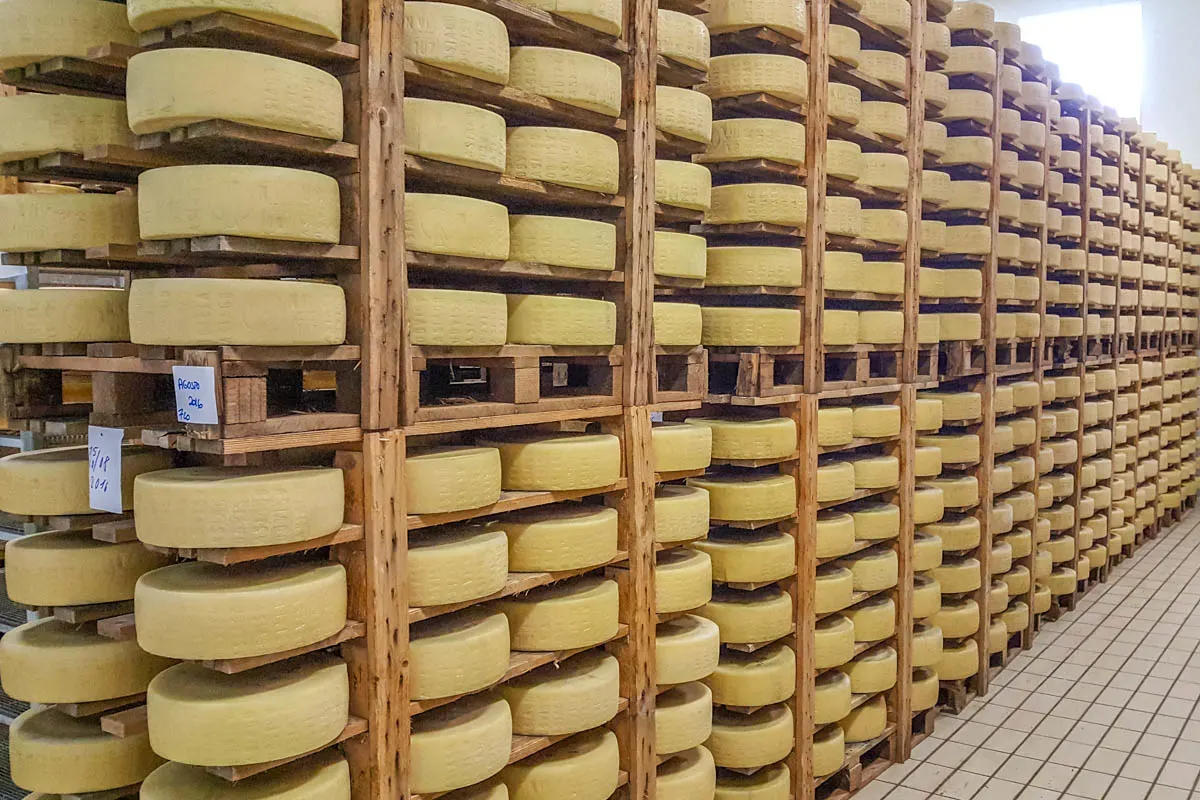
The Veneto is a region in Northern Italy which is particularly famous for its cheeses.
A large number of types of cheese are made here following centuries-old techniques and traditions. Some of Veneto’s cheese, like Asiago and Grana Padano, for example, have been awarded the prestigious DOP mark – protected designation of origin.
If you find yourself in the Veneto as a short- or long-term visitor, don’t miss an opportunity to try the local cheeses.
The above blog post introduces you to five of the most famous and traditional cheese varieties here. In addition, it also gives you suggestions for ten cheese-related experiences you can delight in when in the Veneto, Northern Italy.
I hope that the information above will give you lots of ideas for fun and tasty things to do in the Veneto and will open your taste buds and your culinary horizons to the amazing cheese of this corner of Italy.
More Useful Links about Things to Eat and Do in the Veneto, Northern Italy
- 30 Days of Adventures in the Veneto, Italy – #30daysofadventures
- Top 15 Places to Visit in the Veneto, Italy – The Ultimate Guide
- Video of a Visit to the Cheese Factory in Bressanvido
- Video of the Cheese Cave in Grotte del Caglieron
- Italian Markets – 11 Types of Markets You Can Find in Italy
- Italian Food – 13 Ways to Eat Well in Italy Without Breaking the Bank
- What is Polenta Or 10 Reasons Why You Should Eat Polenta in Northern Italy
- Pasticceria Soraru – The Oldest Patisserie in Vicenza, Italy – Traditions and Secrets of Italian Desserts
- Exploring Venice: Rialto Fish Market
- Frittella – The Taste of the Venetian Carnival
- Panettone – Traditions and Secrets of the King of the Italian Christmas Table
- Mandorlato Veneto – The Taste of Italian Christmas
- Castagnata – Italy’s Roasted Chestnuts Festivals
- Sant’Antonio’s Cakes in Padua, Italy – The Story of the Sweets of the Saint
- The Tortellini of Valeggio sul Mincio
- CioccolandoVi – A Chocolate Festival in Vicenza, Italy
- Cremino – Three-Layered Chocolate Happiness
- How Prosciutto is Made
- The Prosciutto Festival in Montagnana
- Frittelle del Luna Park – An Italian Piece of Fried Sugary Heaven
- Coffee in Italy or 101 Facts about the Italian Coffee Culture
- 3 Cold Coffee-Based Drinks for Your Hot Italian Summer
- Hidden Gems in Venice – 101 Things to Do in Venice, Italy Off the Beaten Track
- 20 Best Things to Do and See in Verona, Italy in One Day – The Ultimate Itinerary with Photos and Tips
- 25 Best Things to Do and See in Vicenza – Northern Italy’s Hidden Gem
- 10 Reasons to Stay in Padua during Your Italy Holidays
- 8 Most Beautiful Villages to Visit in the Veneto, Italy
- Italian Piazzas – 20 Most Beautiful Squares in the Veneto, Northern Italy
- Best 12 Towns to Visit Around Lago di Garda – Italy’s Largest Lake
- Lake Garda with Kids or 11 Best Things to Do at Lake Garda for Families
- Day Trips from Padua, Italy – Over 25 Unmissable Destinations in the Veneto, Lombardy and Emilia-Romagna
- Day Trips from Verona – 16 Destinations to Fall in Love With (With Travel Times and Train Tips)
- Day Trips from Vicenza, Italy – Over 90 of the Best Destinations
- 11 of the Best Day Trips from Venice (With Lots of Photos, Travel Times and Italy Train Tips)
Thank you for reading! Please, leave me a comment, pin the images above or use the buttons right at the top and at the end of this blog post to share it on social media.
For more useful information like this, please, like my blog’s page on Facebook and subscribe to my strictly no-spam newsletter.

